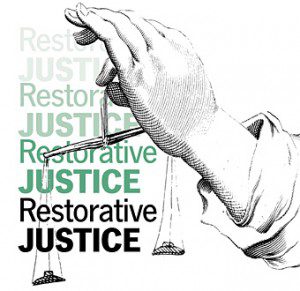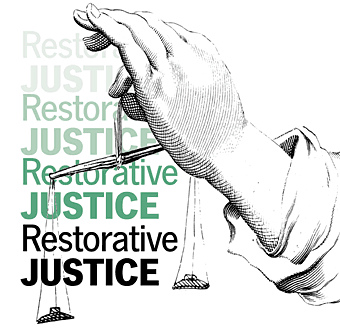 Restorative Justice is generally concerned not with collecting facts, determining fault, or laying blame but with repairing the harm done and moving beyond the victim/offender dichotomy in order to address the feelings and needs of all parties to the conflict.
Restorative Justice is generally concerned not with collecting facts, determining fault, or laying blame but with repairing the harm done and moving beyond the victim/offender dichotomy in order to address the feelings and needs of all parties to the conflict.
by Matthew Johnson, Peace Is Possible Contributor
Most, if not all, arguments made in favor of the traditional, retributive criminal “justice” system are cynical ones. Defenders claim either that some criminals are too evil to live in society and must be incarcerated or executed as a matter of public safety or that there is no tenable alternative to the current system despite its flaws. In her small but compelling book, Are Prisons Obsolete?, Angela Davis points out that prisons (which I use here as a synecdoche) have become self-justifying: We need them because there are dangerous people locked up in them — or so the flawed logic goes.
Approaches that take into account the humanity of the alleged offender are often dismissed as naïve or inconsiderate to the victim, even though these approaches tend to give victims much more power than the current system. The oldest such approach stems from hunter-gather traditions, was codified in the 1970s by the Mennonite community in the eastern United States, and is now referred to as restorative justice. Its success in locations as divergent as New Zealand and Baltimore, Maryland (USA), would suggest that its critics are the naïve ones. While the Community Conferencing Center of Baltimore, which facilitates restorative conferences that include all parties to the conflict seeking to reach a shared agreement, boasts a 95 percent rate of post-agreement compliance, a recent study examining the impact of disparate juvenile justice systems came out heavily in favor of a non-punitive model based on measures such as costs and recidivism rates and cites New Zealand for pioneering the “restorative approach to offending by young people.” Some see it as only a matter of time before a country like New Zealand takes a restorative approach to its entire criminal justice system.
It is difficult to give a concise definition of restorative justice given its many forms and the depth of its philosophical underpinnings. There is even some controversy among enthusiasts over whether to define it at all. Suffice it to say that it is generally concerned not with collecting facts, determining fault, or laying blame but with repairing the harm done and moving beyond the victim/offender dichotomy in order to address the feelings and needs of all parties to the conflict.
Despite its ancient roots and modern success, restorative justice is not widely known. Yet due to the failures of the current justice system and the determination of its proponents, it is slowly entering the mainstream. Restorative processes as they relate to the workplace have become the subject of a recent movie called Face to Face, and citizens across the United States are involved in study circles related to conflict resolution. Nonviolent Communication interest groups are another example.
Although governments can and should take a leading role in promoting and financing restorative processes when and where crime occurs, the demand is such that small organizations and individuals are taking it upon themselves to change the status quo in their communities. Some have even gone a step further and developed a philosophy of justice called transformative justice that takes into account the broader social circumstances that give rise to acts of interpersonal violence. Efforts by activists to apply transformative justice principles to conflict — particularly gender-based violence —within communities have cropped up in cities such as Oakland, Philadelphia, and Washington, D.C.

